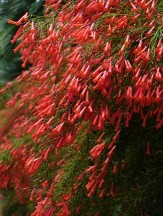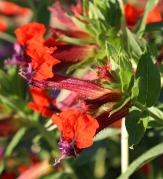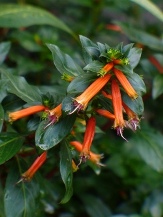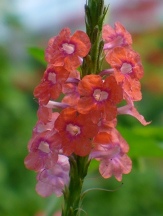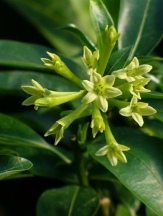The Roselle that we grow is definitely Hibiscus sabdariffa var. sabdariffa of the race ruber that is known for its large, thick, deep clear wine red, crispy, sweet, cranberry flavored calyxes. A vigorous annual to tender perennial, Roselle Hibiscus prefers a warm, mostly sunny position in a well-draining, humus rich, moderately fertile, sandy-loam and free from competition. All parts of the plant are edible including the roots. It will grow foliage and stems all spring and summer with flowering beginning in the shorter days beginning in late summer and fall. The pink tinged, cream colored, typical 5 petaled, 3" wide, citrus flavored Hibiscus flowers attract a variety of native pollinators and are held against the dark burgundy, glossy stems and deep green, burgundy tinged and veined, and typically 3, 5, or 7 lobed foliage. Under good conditions one to several flowers will be born at each leaf axil over a period which typically lasts for several weeks but is dependent on the arrival of the first killing frosts and freezes in your area. Roselle is considered a perennial in frost free climates. Caterpillar host: Gray hairstreak
The pollinated flowers will develop the swollen, deep red, sweet and tangy epicalyxes that the Roselle Hibiscus is known for. You can snap off the finger-like, fleshy red epicalyxes that surround the harder, inner calyxes that form the okra-like seed pod and eat them fresh, use them in salads, to make sauces, drinks, jams, jellies, pies, or dry them to make the Roselle tea that these plants are famous for. The calyx itself is also edible and can be used just like the epicalyx dried or fresh. You can even use the left over seeds to extract a healthful and flavorful Roselle oil. Young stem tips and leaves can be eaten fresh and in salads, the resulting periodic trimming during the spring and early summer also promote increased branching and thus increased calyx production in the fall. Much of the plant, preferably before it gets woody, including the roots can be cooked as a vegetable. All parts except for the roots and seeds are said to have a tangy flavor but the roots are valued as a starch and a thickener and the healing and curative properties of all its parts are hailed by many peoples across the world. Roselle is certainly high in antioxidants, vitamins, and has even been shown to help with high blood pressure and a variety of other ailments.
Roselle is also known as Florida Cranberry, Red Sorrel, Indian Sorrel, Sour-Leaf, Jamaican Sorrel, and Flor de Jamaica. It can grow up to 8' high where it has good growing conditions and 1 plant can produce up to 16 lbs of whole fresh fruit or up to 2 lbs of dried calyxes. Harvest the fruit when the calyxes when they near full size and before they start to become woody, the epicalyxes will be about 1 to 1-1/4" in length, but generally while you can still snap the entire pedicel, or old flower stem, from the plant easily. If they get too old you may need to use snips. You'll want to harvest all remaining calyxes prior to the first first killing frost or freeze. Occasionally, gardeners may be able to successfully extend their harvest, if the first frosts/freezes are mild and brief, by using light, protective covers for the first few cold nights where feasible.
Grows To: 4-8'H space at 3-5' apart
This is the average expected mature height by width in feet or inches. Feet are represented by a single quote and inches by a double quote. Parentheses are used to indicate that the plant can potentially reach that dimension, although the sizes outside of the parentheses tend to be more typical. Under poor growing conditions plants may be slightly to significantly smaller, whereas excellent growing conditions can produce larger more vigorous plants.
USDA Cold Hardiness Zones:
10,11
USDA Cold Hardiness Zones were established to give gardeners, horticulturists, farmers, nurseries, and landscape architects a universal way to describe where a plant will survive with regard to average winter lows for a region. And these are averages, here in zone 8B ('A' represents the colder half of a zone and 'B' represents the warmer half of the zone and they are separated by about 5oF) we have seen single digits but that is the exception but should be noted by the daring gardener. Each zone is separated by 10oF and the map was updated in 2012. We will continue to use the 2012 map, as the 2023 version is unrealistic. Our zones do not always agree but we try to use our own experience as to what can be depended on to return or have known reputable gardens and or horticulturists to reliably grow that plant in zones that are usually colder but sometimes warmer than what other resources have available. For more on stretching your cold hardiness zones see the ""Growing on the Edge Growing Guide". If you do not know your zone you can find it by clicking on the "USDA Cold Hardiness Zones" link here or above.
Outdoor Light: Full sun, Mostly sun
- Full Sun - 8 hours or more of direct sunlight;
- Mostly Sunny - about 6 hours of direct sunlight;
- Partial Shade or Part Shade - about 4 hours of direct sunlight;
- Partial Sun - about 2-4 hours of direct sunlight;
- AM Sun or Morning Sun or Cool Sunlight - cool sunlight like early in the day, like in an eastern exposure, or very late in the day but normally in the shade during the heat of the day;
- Light Shade or Bright Shade - bright indirect sunlight for much of the day;
- Filtered Shade - may receive some amount of direct moving sunlight like through trees but usually not for any extended period especially during the heat of the day;
- Shade or Deep Shade - no or very little direct sunlight, especially not during the heat of the day.
Indoor Light: Direct sunlight
- Direct Sunlight - preferably 4 or more hours of direct sunlight through an unshaded south, east or west facing window;
- High Light - may tolerate no direct sunlight but will need very bright indirect light for 4 or more hours;
- High Indirect Light - bright indirect sunlight for much of the day;
- Medium Light - bright indirect light for 2-4 hours or more;
- Low Light - (few plants can do well under very low indoor light levels but some may tolerate it) no direct sunlight with little bright true sunlight filtering into the area;
- Cool Sunlight or Cool AM(morning) Sunlight - direct sunlight like in an east facing window but not during the heat of the day and will likely also tolerate cool sunlight late in the day, filtered sunlight may also be tolerated.
pH Range: Acidic, Mildly Acidic, Neutral, Mildly Alkaline
- Acidic or Strongly Acidic - pH less than 5.5;
- Mildly Acidic - pH 5.6-6.5;
- Neutral - pH 6.6-7.3;
- Mildly Alkaline - pH 7.4-8.4;
- Alkaline or Strongly Alkaline - pH higher than 8.4;
- Note: Acid loving plants that are grown under alkaline conditions often exhibit nutrient deficiencies since the roots are not able to draw some types of minerals from the soil. Gardenias, for instance, may need to be sprayed with chelated iron. Most plants that are native to alkaline soils can be grown in neutral to mildly acidic soils successfully, although the opposite generally is not true.
Soil & Moisture: Average moisture, moist, to wet and are even reported to tolerate soils with standing water. Well drained sandy loams, rich in organic matter seem to be optimum.
These are the basic soil types and moisture levels where this plant will survive, not necessarily thrive. Drought resistant plants will need to be well-established, usually 2-3 years at a minimum, in the garden or landscape before they are able to withstand lengthy periods (weeks or months) without supplemental water. Most plants will grow and flower and or fruit best where they have ample moisture and nutrients available during the growing season. With that said, many plants, like prairie natives, are quite adaptable to soil types and can thrive in heavy clay as easily as a loose sandy loam.
Do you know the many benefits of a proper organic mulch? Click here to learn more.
A breathable organic mulch is not only aesthetically pleasing (looks nice) but can:
- Help to improve soil organic matter as it breaks down.
- Provide shade for the soil to help reduce moisture loss and prevent weed seed germination.
- Provide soil microbes, mycorrhizae (beneficial fungi), earthworms,and even nematode predators the necessary organic matter and ecosystem to thrive while their actions aid in improving soil tilth and or friability (think of this as the ease with which roots are able to penetrate the soil).
- Provide insulation to protect the crowns of tender perennials and die-back perennials giving gardeners up to an extra half a zone of winter warmth allowing us to grow that which we normally could not.
- Provide soil temperature moderation preventing premature soil warming in winter and providing a cooler root zone in summer.
- So which mulch is our favorite? Our preferred mulch is Longleaf Pine Straw which has: a natural weed preventative for the first year after it is applied; it is sustainably harvested; and it provides protection from soil erosion and doesn't float away, and yet is still both insulative and breathable; while Longleaf Pine Straw appears to last the longest in the garden and landscape in our opinion as compared to Loblolly.
Native To / Origin: India to Malaysia but widely distributed elsewhere
If the plant is a true species and not a hybrid or cultivar this shows where it is normally found naturally. There may be some variation in species that are seed grown, which many of our 'species plants' often are, in order to help maintain genetic diversity. If the plant is a "cultivar" (CULTIvated VARiety) and if the data is available, it shows who developed, discovered it, hybridized it, and introduced it as well as the year it was introduced. With cultivars you will also typically see the cultivar name in quotes at the end of the botanical or scientific name. The great majority of cultivars are clonally propagated from division, cuttings, and tissue culture so that they remain true to type so have the same desirable traits as the parent such as growth habit, flower, fruit, or foliage form. With forms (form or forma), varieties (var.), and subforms (subf.) you will see these abbreviations usually between two lower case words at the end of the botanical name. They may be propagated via division or cuttings but can also be grown from seed depending on the plant and what is required to maintain them true to type. Plants that have PPAF(Plant Patent Applied For) or PP followed by a set of numbers, are illegal to propagate clonally for commercial purposes without the implicit permission of the patent holder. Some plants may have the trademark symbol (™) or copyright (©) in the name. These plants may not be clonally propagated and resold under that name without implicit permission from the copyright or trademark holder. Plants may be both patented and trademarked.
Container Plant Growing Guide - includes uppotting, repotting, potting soil selection, proper watering techniques for containers, what does brown or yellow foliage and green soil indicate, and more
See our Planting A New Plant In the Garden or Landscape, How To, and General Growing Guide for basic planting, initial watering and estabishment watering in instructions
The information listed above that has a black arrow symbol, ‣, before the property name is expandable (just click on it anywhere) and it will contain additional details and a more in-depth description of the terms that we use in this plant's description. This information is based on our years of experience both gardening and growing plants, input from other horticulturists, nursery people, gardeners, and research. If you feel we are missing important information about a plant please feel free to share it with us so that we can pass it on.
![]()

